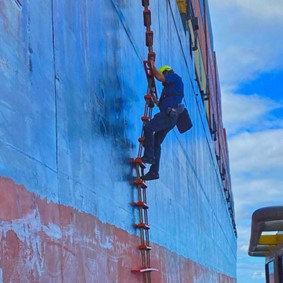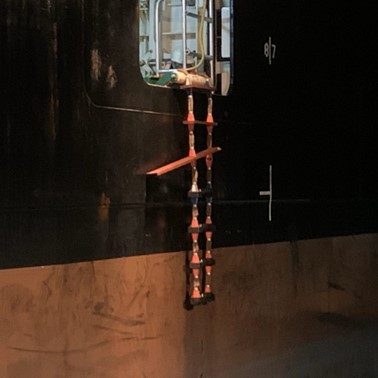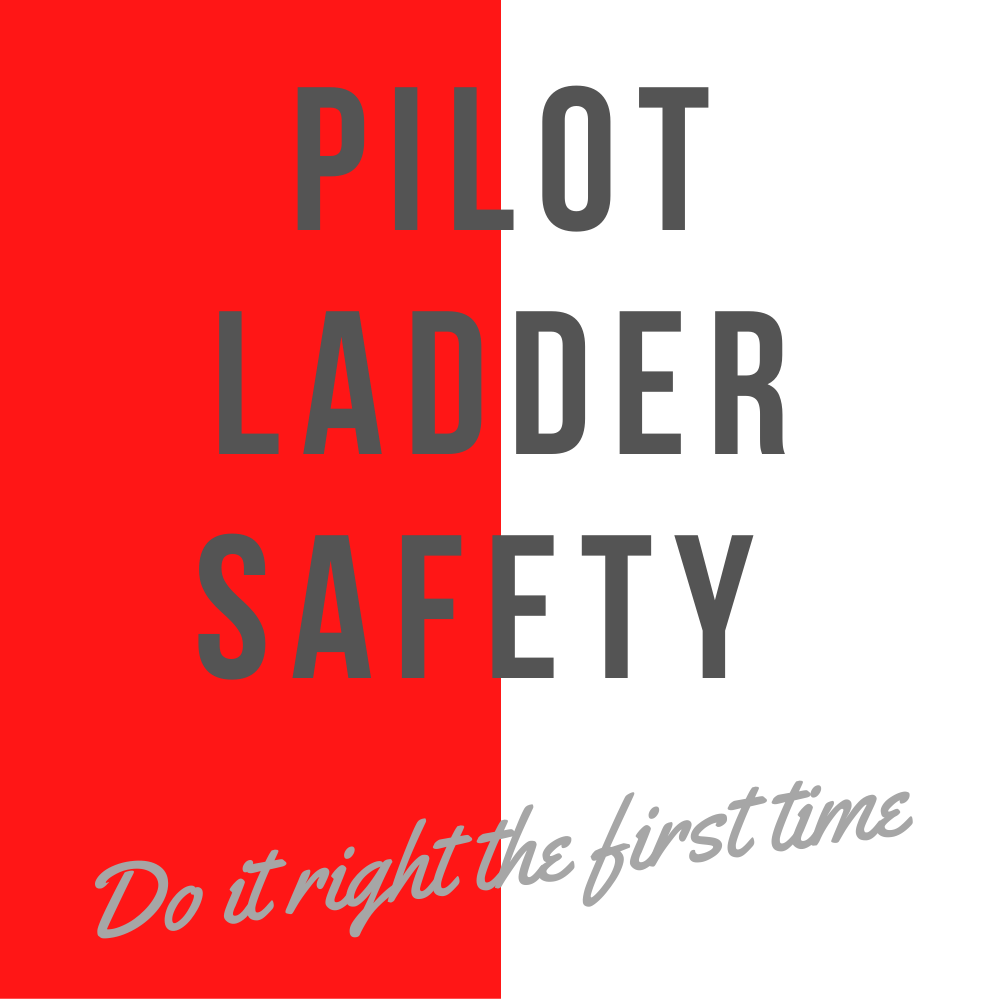
Pilot Ladder Safety – Do It Right The First Time. Every day around the world, maritime pilots board and disembark ships using pilot ladder arrangements. When the pilot ladder is not used properly, a routine procedure can turn into a critical hazard. There are some very good reasons for using the pilot ladder in the correct way: The safety of the pilot and the structural integrity of the pilot ladder. The aim of this website is to increase Pilot Ladder Safety awareness by showing good practice on the rigging and safe use of the pilot ladder. Through this site, by sharing information, news and feedback about good practice, we can raise the standards of Pilot Ladder Safety –
Do It Right The First Time
This website can be used as an online knowlegde base to increase mariners’, pilots’ and maritime professionals’ knowledge about the safe use of pilot transfer arrangements (PTA’s). For every ship there is a different way to rig the ladder properly, due to the nature of its construction. For every ship there is also one way to do it right.

There is a lot that can be improved here
Regulations and guidelines regarding Pilot Ladder safety
Solas convention CH V Reg 23 : Regulations regarding Pilot Transfer Arrangements.
The SOLAS Convention in its successive forms is generally regarded as the most important of all international treaties concerning the safety of merchant ships. The first version was adopted in 1914, in response to the Titanic disaster, the second in 1929, the third in 1948, and the fourth in 1960. The 1974 version includes the tacit acceptance procedure – which provides that an amendment shall enter into force on a specified date unless, before that date, objections to the amendment are received from an agreed number of Parties.
As a result the 1974 Convention has been updated and amended on numerous occasions. The Convention in force today is sometimes referred to as SOLAS, 1974, as amended.
Technical provisions:
The main objective of the SOLAS Convention is to specify minimum standards for the construction, equipment and operation of ships, compatible with their safety. Flag States are responsible for ensuring that ships under their flag comply with its requirements, and a number of certificates are prescribed in the Convention as proof that this has been done. Control provisions also allow Contracting Governments to inspect ships of other Contracting States if there are clear grounds for believing that the ship and its equipment do not substantially comply with the requirements of the Convention – this procedure is known as port State control. The current SOLAS Convention includes Articles setting out general obligations, amendment procedure and so on, followed by an Annex divided into 14 Chapters. (Source: IMO.org)
IMO resolution 1045(27). Recommendation on Pilot Transfer Arrangements
These are recommendations covering the technical detail of pilot transfer arrangements which were adopted in November 2011 and replace IMO Resolution A.889(21).
ISO 799-1 Ships and marine technology – Pilot ladders – Part 1: Design and specification
ISO (the International Organization for Standardization) is a worldwide federation of national standards bodies (ISO member bodies). The work of preparing International Standards is normally carried out through ISO technical committees. Each member body interested in a subject for which a technical committee has been established has the right to be represented on that committee. International organizations, governmental and non-governmental, in liaison with ISO, also take part in the work. ISO collaborates closely with the International Electrotechnical Commission (IEC) on all matters of electrotechnical standardization.
This document is intended to supplement existing IMO requirements for pilot ladders. Since IMO instruments do not include specific requirements for prototype testing of pilot ladders for approval, the tests included in this document are in excess of the existing IMO requirements. The reservation and inclusion of these tests was considered necessary in order to provide a means of ensuring conformance of pilot ladders with the performance requirements prescribed in IMO instruments and in this document.This document can be used for independent acceptance of a pilot ladder complying with SOLAS, in which case certification must be issued from a signatory state of SOLAS.
NOTE ISO 799 is incorporated by reference and footnoted in the International Convention on Safety of Life at Sea (SOLAS) Chapter V Regulation 23.2.3.
This document specifies requirements for pilot ladders of a ship, which are provided to enable a maritime pilot to embark and disembark from a ship safely against a vertical portion of the ship’s hull. It is applicable to merchant ships which embark and disembark maritime pilots with the ship underway. (Source: Iso.org)
In IMO res 1045 article 1.2, explicit reference is made to ISO Standard 799-1 by means of a footnote.
The International Safety Management (ISM) Code
The purpose of the ISM Code is to provide an international standard for the safe management and operation of ships and for pollution prevention.
The Assembly had already invited all Governments, by resolution A.443(XI), to take the necessary steps to safeguard the shipmaster in the proper discharge of his responsibilities with regard to maritime safety and the protection of the marine environment.
In resolution A.680(17), the Assembly recognized the need for appropriate organization of management to enable it to respond to the need of those on board ships in order to achieve and maintain high standards of safety and environmental protection.
Recognizing that no two shipping companies or shipowners are the same, and that ships operate under a wide range of different conditions, the Code is based on general principles and objectives, which include assessment of all identified risks to one Company’s ships, personnel and the environment and establishment of appropriate safeguards.
The Code is expressed in broad terms so that it can have a widespread application. Clearly, different levels of management, whether shore-based or at sea, will require varying levels of knowledge and awareness of the items outlined.
The cornerstone of good safety management is commitment from the top. In matters of safety and environment protection it is the commitment, competence, attitudes and motivation of individuals at all levels that determines the end result.(Source: IMO.org)
1.2.3 The safety-management system should ensure: .1 compliance with mandatory rules and regulations; and .2 that applicable codes, guidelines and standards recommended by the Organization, Administrations, classification societies and maritime industry organizations are taken into account.
Pilot Ladder Safety as a System
Pilot ladder safety is a chain-like system of regulations, recommendations, industry standards and procedures. If any of these links is broken, the safety as a system fails with possible fatal consequences.

Regulations – Guidelines – Standard – Procedures
The IMO resolution A.1045(27) on Pilot Transfer Arrangements highlights the importance of safe pilot transfers. The first two articles encourage ship designers, equipment manufacturers, and pilot ladder producers to ensure that all transfer arrangements effectively meet the SOLAS requirement:
“All arrangements used for pilot transfer shall efficiently fulfill their purpose of enabling pilots to embark and disembark safely.”
Even when ships, equipment, and pilot ladders are designed for this purpose and a Safety Management System (as per ISM) is in place, incidents with pilot ladders and non-compliant transfer arrangements still occur.
The reason isn’t always straightforward, but a lack of awareness and training plays a major role. This website aims to improve understanding and promote safer pilot ladder practices.
So what’s a pilot ladder?
Not every ladder hanging overboard is a pilot ladder!
A true pilot ladder meets the manufacturing and material requirements outlined in ISO 799-1. Ladders that comply with this standard are labeled with the code:
“Pilot Ladder ISO 799-1 – S (number of steps) – L (length in meters)”
This designation should be clearly marked on both the bottom spreader and the top step.
If a ladder is labeled “Embarkation Ladder”, it is NOT a pilot ladder. Always check before use!
For the various pages of this website, the applicable SOLAS requirements are marked in pink.
The applicable IMO 1045(27) resolution recommendations are marked in grey.
The applicable International safety management (ISM)-Code regulations are marked in green.
Solas Ch V Reg 23: General regulations
1. Application
1.1. Ships engaged on voyages in the course of which pilots may be employed shall be provided with pilot transfer arrangements.
1.2. Equipment and arrangements for pilot transfer which are installedon or after 1 July 2012 shall comply with the requirements of this regulation, and due regard shall be paid to the standards adopted by the Organization.
1.3. Except as provided otherwise, equipment and arrangements for pilot transfer which are provided on ships before 1 July 2012 shall at least comply with the requirements of regulation 17 or 23, as applicable, of the International Convention for the Safety of Life at Sea, 1974, in force prior to that date, and due regard shall be paid to the standards adopted by the Organization prior to that date.
1.4. Equipment and arrangements installed on or after 1 July 2012, which are a replacement of equipment and arrangements provided on ships before 1 July 2012, shall, in so far as is reasonable and practicable, comply with the requirements of this regulation.
1.5. With respect to ships constructed before 1 January 1994, paragraph 5 shall apply not later than the first surveyon or after 1 July 2012.
1.6. Paragraph 6 applies to all ships.
2. General
2.1. All arrangements used for pilot transfer shall efficiently fulfil their purpose of enabling pilots to embark and disembark safely. The appliances shall be kept clean, properly maintained and stowed and shall be regularly inspected to ensure that they are safe to use. They shall be used solely for the embarkation and disembarkation of personnel.
3. Transfer arrangements
3.1. Arrangements shall be provided to enable the pilot to embark and disembark safely on either side of the ship.
3.2. In all ships, where the distance from sea level to the point of access to, or egress from, the ship exceeds 9 m, and when it is intended to embark and disembark pilots by means of the accommodation ladder, or other equally safe and convenient means in conjunction with a pilot ladder, the ship shall carry such equipment on each side, unless the equipment is capable of being transferred for use on either side.
IMO Resolution A.1045(27)
RECOMMENDATION ON PILOT TRANSFER ARRANGEMENTS
1 GENERAL
Ship designers are encouraged to consider all aspects of pilot transfer arrangements at an early stage in design. Equipment designers and manufacturers are similarly encouraged, particularly with respect to the provisions of paragraphs 2.1.2, 3.1 and 3.3.
2 PILOT LADDERS
A pilot ladder should be certified by the manufacturer as complying with this section or with the requirements of an international standard acceptable to the Organization.1
2.1 Position and construction
2.1.1 The securing strong points, shackles and securing ropes should be at least as strong as the side ropes specified in section 2.2 below.
